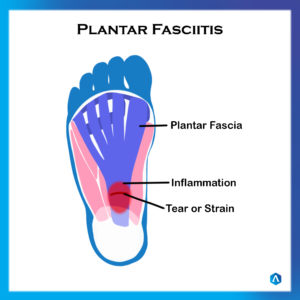Plantar Fasciitis
- Dr Abbie Clinics
- August 26, 2019

Excessive pronation also causes an elongation of the plantar fascia that tears from where it is attached at the heel.
Symptoms
Severe to moderate pain in the heel or base of the foot indicate that you have plantar fasciitis. The pain will restrict how you walk and can keep you awake at night. Plantar Fasciitis is a very common and is experienced by thousands of Australians each day.
Assessment
To confirm you have plantar fasciitis it is recommended you seek a thorough biomechanical and physical assessment to determine the actual cause and points of pain so a specific treatment plan that suits you can be provided. If only one foot has plantar fasciitis then this could also be related to leg length difference, where the longer leg rolls in to pronate the foot to level with the shorter leg.
Treatment
Treatment can include stretching, proper footwear, strapping, foot mobilisation, dry needling, shockwave therapy and orthotics. Anti-inflammatory medication may also be required.
- Stretching exercises help to gently release any tension in the plantar fascia and reduce inflammation.
- Proper footwear helps in keeping the foot stable and balanced in everyday activities.
- (Low Dye) Strapping – removes the forces applied to the plantar fascia.
- Foot mobilisation – to help re-align the bones of the foot to reduce the stress on the plantar fascia.
- Dry needling – creates an inflammatory response within the body too breakdown the scar tissue.
- Shockwave therapy – mechanical shocks stimulating a healing response to the affected plantar fascia.
- Orthotics are corrective, medically prescribed innersoles, designed to support, control and align the foot whilst correcting mechanical issues from the feet up, treating the cause.Use of orthotic therapy is an excellent regime as it helps realign the body’s biomechanical structure and control any excess foot pronation, eliminating the pull that occurs at the insertion point. They also help stabilise the heel bone and the growth plate to decrease inflammation and pain. Gel and rubber gradient heel lifts are advertised to take the tension from the heels, but do not treat the cause of pain and can even create an unstable platform for everyday walking.
If you are experiencing these symptoms call 1800 DR ABBIE or email reception@dr-abbie.com to organise an assessment.


